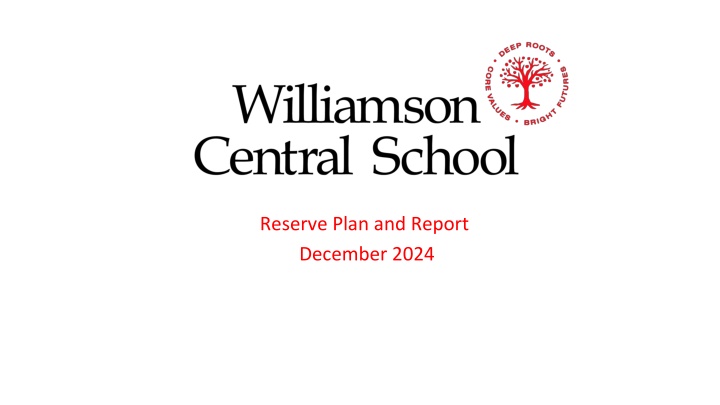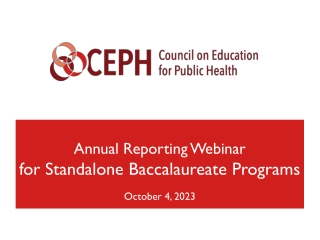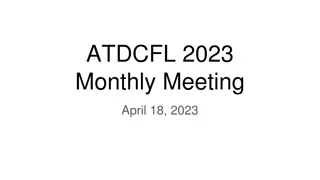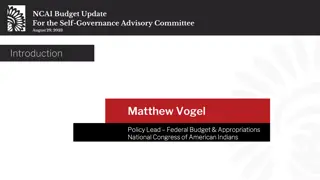
Effective Reserve Fund Management Strategies for Financial Stability
Learn about the importance of reserve funds in prudent financial management and strategic planning. Explore how setting aside funds for future needs can help mitigate risks, reduce costs, and support long-term financial health. Understand key considerations in establishing and managing reserve funds to ensure financial stability and accountability.
Download Presentation

Please find below an Image/Link to download the presentation.
The content on the website is provided AS IS for your information and personal use only. It may not be sold, licensed, or shared on other websites without obtaining consent from the author. If you encounter any issues during the download, it is possible that the publisher has removed the file from their server.
You are allowed to download the files provided on this website for personal or commercial use, subject to the condition that they are used lawfully. All files are the property of their respective owners.
The content on the website is provided AS IS for your information and personal use only. It may not be sold, licensed, or shared on other websites without obtaining consent from the author.
E N D
Presentation Transcript
Reserve Plan and Report December 2024
Table of Contents Reserve Funds Overview Comptroller s Commentary Balances and Activity Unemployment Insurance Reserve State Retirement System Employee Benefits Accrued Liability Reserve Liability Reserve Insurance Reserve Tax Certiorari Reserve Capital Reserve Bus Purchase Reserve Debt Service Reserve Reserve Summary 3 4 5 6 7 8 9 10 11 12 13 14 15
WILLIAMSON CSD RESERVE FUNDS OVERVIEW Reserve funds, like other savings plans, are mechanisms for accumulating cash for future capital projects and other allowable purposes. The practice of planning ahead and systematically saving for capital acquisitions and other contingencies is considered prudent management. Saving for future capital needs can reduce or eliminate interest and other costs associated with debt issuances. Similarly, certain reserve funds can be utilized to help protect the financial position of the district against known risks (a potential lawsuit) or unknown risks (a major ice storm). Most reserve funds are established to provide resources for an intended future use. An important concept to remember is that a reserve fund should be established witha clear intent or plan in mind regarding the future purpose, use and, when appropriate, replenishment of funds. Reserve funds should not be merely a parking lot for excess cash or fund balance. Local governments and school districts should balance the desirability of accumulating reserves for future needs with the obligation to make sure taxpayers are not overburdened by these practices. There should be a clear purpose or intent for reserve funds that aligns with statutory authorizations. Each statute that authorizes a reserve fund sets forth a particular underlying purpose for the fund. For example, provisions of the General Municipal Law (the GML) and the Education Law allow municipalities and school districts, respectively, to establish capital reserves for future equipment purchases and capital improvements. The GML also authorizes the establishment of an employee benefit accrued liability reserve for the payment of the monetary value of accumulated, unused leave time to employees upon separation from service. While reserve types and purposes are defined in detail later in this document, reserves can be utilized in the following ways: Save funds to offset future taxpayer expense Insulate the district from liability and financial loss Prepay certain types of expenses from current year s funds Provide a buffer against spikes in certain areas of contractual benefit costs While outside entities may opine as to the level of reserves a district chooses to carry, the appropriate balance of each reserve fund is determined solely by the Board of Education. It is important to note that in most cases a district s sole source of funding for reserves is from unexpended appropriations. Therefore, multi-year financial planning and budgeted surpluses are integral to maintaining healthy financial operations and supporting district programs and services through periods of economic uncertainty.
COMPTROLLERS POSITION ON RESERVE FUNDS FOR STRATEGIC PLANNING In our personal lives, saving or putting money aside to finance future needs is a common practice. Unquestionably, strong arguments can be advanced for accumulating funds. The disputable philosophy, live for today and let tomorrow take care of itself can easily be refuted with many savingsslogans such as prepare for a rainy day. These practices are equally important for New York s local governments. Legally established reserves can provide many benefits to municipalities* and their citizens. Available moneys can be set aside to finance all or part of planned projects, thereby reducing the need to issue costly debt. Reserves canprovide a degree of financial stability. In uncertain economic times, reserve funds may give managers options other than cutting services or raising taxes. In good times, moneys not needed for current purposes can often be set aside for future benefit. Planning today and saving incrementally for expected future events can help mitigate the financial impact of major, nonrecurring or unforeseen expenditures on your annual operating budget. Establishing and funding allowable reserve funds for a clear purpose can help smooth out spikes in the annual budget and in the real property tax levy. Source: Office of the New York State Comptroller Local Management Guide for Reserves http://www.osc.state.ny.us/localgov/pubs/lgmg/reservefunds.pdf COMPTROLLER S POSITION ON LONG-TERM FINANCIAL PLANNING OSC recommends using revenues from unexpected windfalls or other nonrecurring sources for one-time needs or to build reserves, rather than spending them on recurring expenses. You should build a plan that allows you to break out these non-recurring revenues and to track them separately from recurring revenues. You may also wish to track non-recurring expenditures to determine if you are using one-time windfalls to fund one-time expenses or establish reserves. If, however, you are funding an increasing portion of your budget with such revenues, you may be using one-shots to address a structural imbalance between recurring revenue and recurring expenses. Your plan should aim to address this situation with long-term revenue or expenditure adjustments. Source: Office of the New York State Comptroller, Multi-Year Financial Planning (2017) https://www.osc.state.ny.us/files/local-government/publications/pdf/multiyear.pdf
2023-2024 RESERVE SUMMARY BALANCES AND ACTIVITY
UNEMPLOYMENT INSURANCE RESERVE Purpose:This reserve fund is used to pay the cost of reimbursement to the State Unemployment Insurance Fund for payments made to claimants. The reserve may be established by board action and funded by budgetary appropriations or other funds as may be legally appropriated (General Municipal Law, 6-m). Analysis: The District has utilized funds from this reserve to pay claims and will continue to do so. During the last several years the District has experienced more unemployment activity and also recovered some costs from the State of New York. As the State continues to be uncertain on its ability to fund Foundation Aid due to its economic climate, the District should retain a balance in the unemployment reserve that could defray the costs of a reduction in force should it become necessary. Ideal Balance: Methodologies for this determination vary as yearly claims can fluctuate greatly dependent upon the macroeconomic climate. The ideal balance recommended is approximately $525,000. This value would be sufficient to sustain the maximum claims (26 weeks at $504) for a reduction of up to 40 positions. As Governor s have threatened aid withholdings of up to 20% of total state aid, the ability to sustain claims in a climate of multi-year revenue reductions must be considered. Any additional balance beyond the ideal balance would be intended to address the potential for extended benefits during an economic crisis.
NYS EMPLOYEE RETIREMENT SYSTEMS CONTRIBUTION RESERVE (ERS/TRS) Purpose: For the payment of retirement contributions which is defined as all or any portion of the amount payable to either the New York State and Local Employee Retirement System or the NYS and Local Police and Fire Retirement Systems pursuant to section 17 or 317 of the Retirement and Social Security Law (General Municipal Law, 6c, d, e, f, or g, and Section 3651 of the Education Law). The TRS sub-fund was created as a sub-fund by Educational Law Section 521 beginning in 2019, and Williamson s was established 6/17/20 by Resolution of the Board of Education. Analysis:These funds will be used as a budgeted revenue source each year in the District s annual budget to help offset ERS and TRS costs as needed. Ideal Balance: The ideal balance for the ERS fund is a minimum of approximately $1.266M, which is equivalent to 3 years of budgeted contributions to the retirement system. The ideal balance for the TRS sub-fund is $900,000, which is roughly equivalent to the sum of 10% of proceeding years eligible payroll. This is the maximum allowed by section 521 of educational law. That value is still less than one year s budgeted contributions to the system. Combined, the Districts ideal funding for employee retirement systems would be $2.166M aggregate.
EMPLOYEE BENEFITS ACCRUED LIABILITY RESERVE Purpose: Reserve for Employee Benefit Accrued Liability (GML 6-p) is used to reserve funds for the payment of accrued employee benefits due to an employee upon termination of the employee s service. This reserve may be established by a majority vote of the Board and is funded by budgetary appropriations or other reserves and funds that may be legally appropriated. Analysis: This reserve is used to fund the retirement incentive liability for eligible contract member employees who have earned unused accumulated sick days. An annual calculation is performed at the close of each fiscal year to determine the current liability of eligible members at the close of the year. TheDistrict typically budgets an annual appropriation from this reserve as a General Fund Revenue source to help offset the District s non-elective 403(b) retirement costs provided as a retirement incentive based on unused accumulated sick days. While $45,000 has been appropriated to support the 2024-25 budget, it is important to note that only the payments for this purpose can be charged to the reserve, which may be less than the appropriated value. Ideal Balance: The ideal balance for this reserve is approximately $740,000, which is the audited balance of compensated absences as of 2024. Additionally, unlike OPEB liabilities for which a savings mechanism for earned benefits does not exist, the EBALR reserve helps the district fund its future payment obligations with revenues from the period in which the benefits were earned.
LIABILITY RESERVE Purpose: This reserve fund is similar to the insurance reserve described next, in that it is used to pay for property loss and liability claims incurred. Separate funds for property loss and liability claims are required and these reserves may not in total exceed 3% of the annual budget or $15,000 whichever is greater. (Education Law, 1709, Subdivision 8-c). Analysis: The balance in this Liability Reserve has been deemed as a reasonable amount to protect against any potential property losses inwhich the District might reasonably incur, or claims against the District for negligence. In May 2014, the Voters approved the transfer of up to $100,000 from the Liability Reserve to support the General Fund budget. In May 2018, the Voters approved the transfer of up to $200,000 from the Liability Reserve to support the 2018-19 General Fund budget. Ideal Balance: As the maximum allowable by law is 3% of the operating budget the ceiling for funding this reserve is approximately $860,000 forthe 2024-25 school year. The reserve has been utilized to fund the operating budget in recent years. The ideal balance for this reserve is approximately$860,000. This would allow the District insulation from losses as its infrastructure ages and the legal climate for school operations becomes more litigious.
INSURANCE RESERVE Purpose: This reserve fund is used to pay judgments, claims, incidental costs and professional services connected with the investigation and settlement of claims. The reserve is funded by budgetary appropriations or any other permissive referendum. The amount that can be paid into the reserve during each fiscal year is limited to 5% of the annual budget. There is, however, no limit upon the amount which may be accumulated in the fund (General Municipal Law, 6-n). Analysis: The District negotiated lower insurance premiums nearly $1,800 by raising its deductible amounts to $2,500 on property ($1,000 on vehicles) in the 2009-10 school year. By lowering insurance costs and utilizing a greater share from the Insurance Reserve to cover uninsured claims, the District is making better use of its reserves and saving taxpayer dollars on an annual basis. In 2011- 12, the District applied the deductibles from 1 insurance claim for $1,000. In addition, the Board also approved the appropriation from the Insurance Reserve of $160,000 to settle a claim for an employee. In 2012-13 a $500 deductible and in 2017-18 a $1,000 deductible was applied to the reserve. Ideal Balance: There are a number of liability exclusions stated in the District s umbrella liability coverage, including but not limited to pollution, asbestos, mold, and pandemic. As each of these pose a risk of loss to the district due to unforeseen building conditions, systems failures, or acts of nature, it is prudent for the District to retain a balance to mitigate these exposures. Additionally, cybercrime introduces a layer of risk as more personal data is housed electronically by school districts. The average ransomware cost can cost millions to fully recover and restore systems. As such, the District has determined the current balance to be adequate, and if this reserve is utilized to offset any incurred loss, the District will evaluate refunding the reserve at that time.
TAX CERTIORARI RESERVE Purpose: The governing board of any school district, by resolution, may establish a reserve to refund taxes of the current year in tax certiorari proceedings. Establishing or expending from the reserve does not require voter approval. Amounts not necessary to refund taxes must be returned to the unreserved fund balance of the general fund by the first day of the fourth fiscal year following the year for which the reserve was created. (Education Law 3651, Sub.1a, 3a) Analysis: Whispering Woods Estates has discontinued their certiorari case which removes a liability of roughly $130,000 (approximately $5.3M of value disputed) for the 2019 and 2020 tax years. As such, Walgreens is the only active case with a yearly liability of roughly $85,000 (approximately $3.4M of value disputed) dating back to 2014. Only 4 years of claims can be supported by this reserve which leaves a total exposure of approximately $340,000. Ideal Balance: It is unlikely the claims will be settled at the full disputed value, however, with the existing balance of this reserve the district is very well insulated against the remaining claim and will re- evaluate if the status of that claim changes.
CAPITAL RESERVE Purpose: The Capital Reserve Fund is used to pay the cost of any object or purpose for which bonds may be issued. Voter authorization is required for both the establishment of the reserve and payments from the reserve. The form of the required legal notice for the vote on establishing the reserve and the form of the proposition to be placed on the ballot are set forth in 3651 of the Education Law. Analysis:The District s building aid ration is approximately 85%, meaning that roughly 85% of the cost of eligible and approved capital work will be reimbursed based upon amortization schedules set by NYSED. As not all capital work will be eligible for building aid, a more realistic local share is approximately 20% of total project budgets. The chart below shows a total aggregate balance of $5,343,336 as of June 30, 2024. The 2016 capital reserve has reached it s funding capacity, while the 2022 capital reserve is able to absorb additional funding. Ideal Balance: The ideal balance for this reserve is an amount sufficient to fund the local share of the next capital project(s). In December of 2021 voters authorized the use of $2,625,000 for the current capital project nearing completion. The most recent Building Condition Survey on file for the District identifies more than $65 million in infrastructure and mechanical systems repairs and updates. While this report is current, new needs will continually be identified, and systems will continue to age. As such, the local share (as defined as 20% of the total cost) of $65 million in capital needs is $13 million.
BUS PURCHASE RESERVES Purpose: The bus Purchase Reserve Fund is a capital reserve for the specific use of purchasing vehicles for student transportation. Voter authorization is required for both the establishment of the reserve and payments from the reserve. A reserve was authorized by a public vote on May 21, 2019 for a term of 5 years and a maximum aggregate funding limit of $750,000. Another reserve was authorized by public vote on May 18, 2021 for a term of 10 years and a maximum aggregate funding limit of $2,500,000. In May of 2024, a $5,000,000 Transportation Vehicle Reserve was authorized. The form of the required legal notice for the vote on establishing the reserve and the form of the proposition to be placed on the ballot are set forth in 3651 of the Education Law. Analysis: As of 6/30/24, the aggregate funding to the 2021 and 2024 reserves was approximately $3,320,000. In years past the district hasregularly utilized this reserve to fund the local component of bus purchases, while utilizing rolling BANS to fund the state aided component of the purchase. In July of 2022, the district paid off all bus BANS and moved to utilizing reserves to purchase buses. This shift in purchasing saves the district on high interest rates, bond rating fees, advisory fees and legal fees. The District s transportation aid rate is approximately 85%, meaning that 85% of the cost of bus purchases will be reimbursed by the state over the course of 5 years. The chart below combines the balance of the prior and current reserves for bus purchases. The district will seek authorization for an additional bus purchase reserve due to reaching the available funding capacity. Ideal Balance: The ideal balance of this reserve is the maximum funding authorized in order to continue supporting the purchase of buses from reserves. Over the last several years the district is replacing 3-4 buses a year as the fleet inventory ages on a cyclical basis. With the mandate for the electrification of buses in sight, an increased amount of funding will be required to continue the cost savings mentioned above. At this time manufacturers are anticipating a 100-150% increase in the cost of one bus.
MANDATORY RESERVE FOR DEBT SERVICE Purpose: Upon the sale of district property that was financed by obligations which remain outstanding at the time of sale, a reserve must be established for the purpose of retiring the outstanding obligations. The funding of the reserve is from the proceeds of the sale of district property or capital improvement (General Municipal Law, 6-l). The debt service reserve is not accounted for in the general fund, but rather the debt service fund. Analysis: The Debt Service Fund is used as a budgeted revenue source each year in the District s annual budget to help offset principal and interest as needed. Transfers from the Debt Service Fund can be made to the general fund to offset budgeted debt service payments. Utilization can help maintain a negative tax cap capital exclusion which means there will be currently no tax impact to the Districts debt service payments to support prior capital expenditures. Ideal Balance: There is no ideal balance for the Reserve for Debt service as it is the accumulation of funding from prior projects that shall be used to retire debt obligations. One consideration of utilizing this reserve to support the general fund budget is its functionality in the tax cap calculation, wherein any sum utilized will reduce the capital exclusion in the tax cap formula. As the District s long-term debt service schedule demonstrates there will be a taxable capital exclusion in the coming years, it is advisable to use these funds judiciously to gradually scale in any local capital exclusion.














